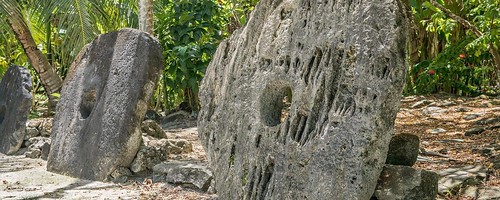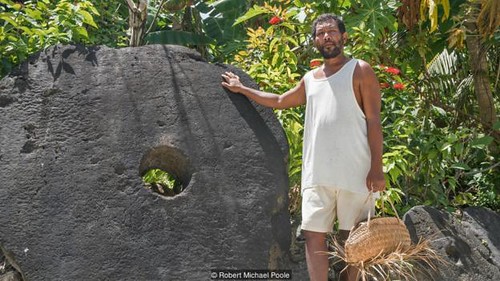
PREV ARTICLE
NEXT ARTICLE
FULL ISSUE
PREV FULL ISSUE
TRAVEL ARTICLE HIGHLIGHTS YAP STONE MONEYDick Hanscom and Arthur Shippee forwarded this BBC Travel article about the island of Yap and its famous stone money discs. Thanks. -Editor
 Arriving on the tiny Micronesian island of Yap will fill even the most jaded traveller with a sense of awe. The single daily flight comes in over dense forests, taro swamp, shallow lagoons and a web of mangroves, all surrounded by fringing reef. But the real wonderment doesn't come from the idyllic scenery, nor from the greeting by a Yapese girl in a traditional hibiscus skirt. It's when you first come face-to-face with a piece of giant stone money. Hundreds of these extraordinary, human-sized discs of rock are scattered all over the island; some outside the island's few hotels, others in rows close to the beach or deep in the forests. Each village even has a stone money bank where pieces that are too heavy to move are displayed on the malal (dancing grounds). "My family owns five stone money of a good size," said Falmed (Yapese just use one name), a taxi driver I flagged down to take me to Mangyol stone money bank in Yap's eastern province of Gagil. Five, it turns out, is a good haul, since many islanders don't own any stones. The unique stone currency has been in use here for several centuries, although no-one is quite certain when the concept began. What is known is that each one is different, and they are as heavy with meaning as they are in volume of limestone, carved and voyaged by the Yapese all the way from Palau, an island nation 400km to the south-west. On their return from Palau, the sailors would give the carved stone money to the high chiefs who would gather from different villages to welcome back the sailors and the stones. The chiefs would keep the larger ones and two fifths of the smaller ones. They would also give names to some stones, usually choosing their own name or that of relatives, and confirm the stones as legitimate by giving a value based on an even older currency system: yar (pearl shell money). The stones could then enter circulation and be bought by anyone. "If the chief says OK, 50 shell money for each stone money, if I have that I will make the trade and own one," explained Edmund Pasan, a canoe builder from the northern province of Maap.  Today, shell money has been replaced by the almighty US dollar for day-to-day transactions like grocery shopping. But for more conceptual exchanges, like rights or customs, stones remain a vital currency for Yap's 11,000 residents. Falmed's family has only used its money twice, and one was as an apology. "We used it for one of my brothers who made trouble for another family," Falmed revealed remorsefully. His brother's marriage had failed. "One of the chiefs, his daughter got one piece of stone money as an apology, and they accepted it. When it comes to high ranks, you have to use stone money." See the complete article online for much more information, and more images. -Editor
To read the complete article, see: Wayne Homren, Editor The Numismatic Bibliomania Society is a non-profit organization promoting numismatic literature. See our web site at coinbooks.org. To submit items for publication in The E-Sylum, write to the Editor at this address: whomren@gmail.com To subscribe go to: https://my.binhost.com/lists/listinfo/esylum All Rights Reserved. NBS Home Page Contact the NBS webmaster 
|